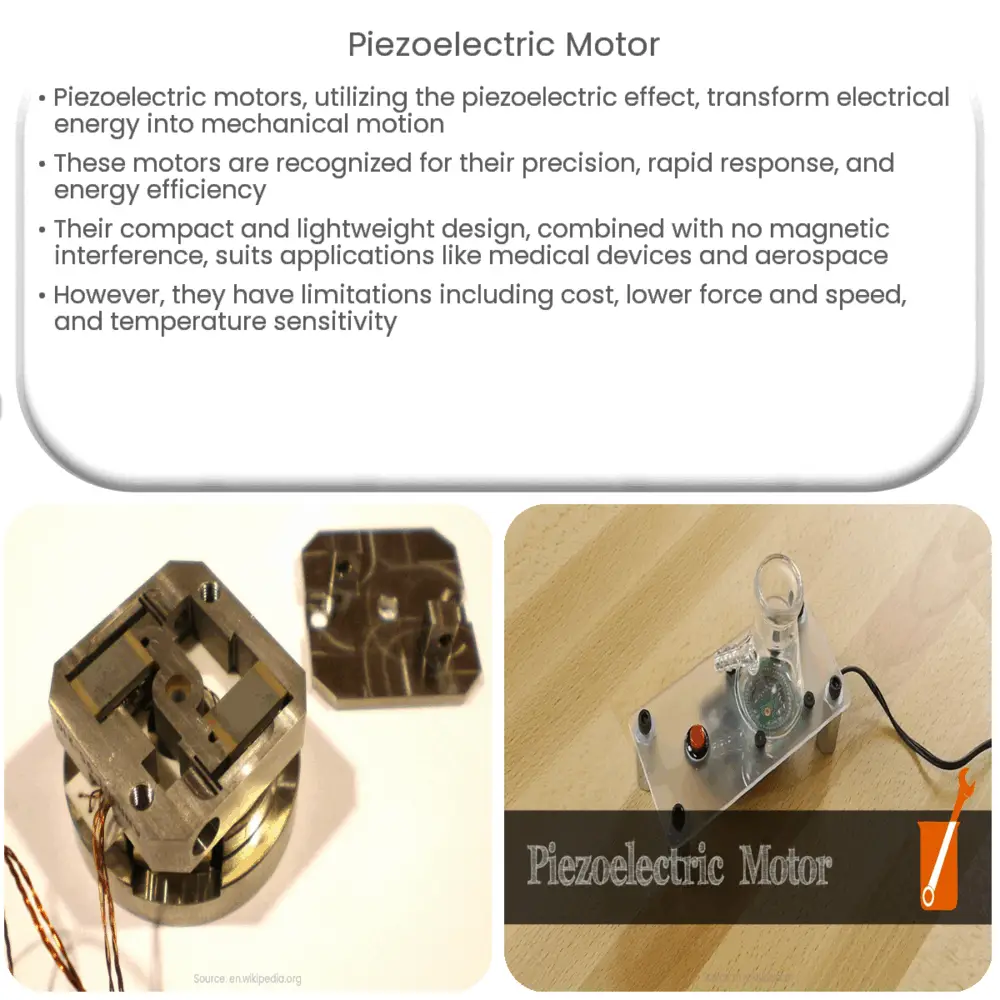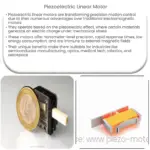Piezoelectric motors offer precision motion control, fast response, and energy efficiency, ideal for applications in medical, aerospace, and nanotechnology.

Piezoelectric Motors: A Revolutionary Technology for Precision Motion Control
Introduction
The world of motion control has been consistently evolving, with new technologies being developed to cater to the ever-growing need for precise, efficient, and reliable solutions. Among the numerous innovations, piezoelectric motors have emerged as a promising technology, offering unparalleled precision and control. In this article, we will delve into the fundamentals of piezoelectric motors, their various types, and the advantages they hold over traditional motors.
What are Piezoelectric Motors?
Piezoelectric motors, also known as piezo motors, are a type of electric motor that utilizes the piezoelectric effect for motion generation. The piezoelectric effect is a phenomenon in which certain materials, primarily crystals and ceramics, generate an electric charge when subjected to mechanical stress. Conversely, these materials can also exhibit a mechanical deformation when an electric field is applied. Piezoelectric motors exploit this reversible effect to transform electrical energy into mechanical motion or vice versa.
Types of Piezoelectric Motors
There are several types of piezoelectric motors, each with unique design features and applications. Some of the most common types include:
- Linear Piezoelectric Motors – These motors generate linear motion by applying an alternating voltage to a piezoelectric element, causing it to expand and contract. Linear piezoelectric motors are widely used in precision positioning applications, such as microscopy and semiconductor manufacturing.
- Rotary Piezoelectric Motors – These motors generate rotary motion by using the piezoelectric effect to induce a twisting or bending motion in a piezoelectric element. Rotary piezoelectric motors are commonly used in applications like autofocus systems in cameras, and precision rotary stages.
- Ultrasonic Piezoelectric Motors – Ultrasonic motors use high-frequency vibrations generated by piezoelectric elements to create motion. They are often used in applications requiring high-speed movement and low power consumption, such as medical devices and robotics.
Advantages of Piezoelectric Motors
Piezoelectric motors offer several benefits over traditional electromagnetic motors, including:
- Precision and Resolution – Piezoelectric motors can achieve nanometer-level precision, making them ideal for applications that demand high accuracy and resolution, such as microscopy and nanotechnology.
- Fast Response – Due to the direct coupling between the electrical input and mechanical output, piezoelectric motors can respond rapidly to changes in voltage, enabling faster acceleration and deceleration compared to traditional motors.
- Energy Efficiency – Piezoelectric motors consume less power, as they only require energy to change their shape and maintain their position. This makes them suitable for battery-powered devices and applications where energy efficiency is critical.
Compact and Lightweight Design
Piezoelectric motors are generally smaller and lighter than traditional electromagnetic motors due to their simple design, which consists of piezoelectric elements and minimal mechanical components. This compactness allows for easy integration into space-constrained applications, such as miniaturized medical devices, portable electronics, and aerospace systems.
No Magnetic Interference
Unlike electromagnetic motors, piezoelectric motors do not generate a magnetic field, making them suitable for applications where magnetic interference can be detrimental, such as magnetic resonance imaging (MRI) machines and sensitive electronic equipment.
High Holding Force and Vacuum Compatibility
Piezoelectric motors can maintain their position without consuming power, providing a high holding force when the voltage is removed. This feature makes them ideal for applications requiring a stable position even when the power supply is turned off. Additionally, piezoelectric motors do not rely on lubricants, which makes them compatible with vacuum environments, such as those found in semiconductor manufacturing and space exploration.
Challenges and Limitations
Despite their numerous advantages, piezoelectric motors also have some limitations:
- Cost – Piezoelectric motors can be more expensive than traditional motors due to the specialized materials and manufacturing processes involved. However, the benefits of improved performance and efficiency can offset the higher initial costs in certain applications.
- Force and Speed – While piezoelectric motors offer high precision and resolution, they generally provide lower force and speed compared to electromagnetic motors. This limitation can be a drawback in applications requiring high torque or rapid movement.
- Temperature Sensitivity – The performance of piezoelectric materials can be sensitive to temperature changes, which may affect the motor’s accuracy and stability. Proper thermal management and temperature compensation techniques can help mitigate this issue.
Conclusion
Piezoelectric motors have emerged as a powerful alternative to traditional electromagnetic motors, offering unmatched precision, rapid response, and energy efficiency. Their compact size, lightweight design, and absence of magnetic interference make them an attractive choice for a wide range of applications, from microscopy and semiconductor manufacturing to medical devices and aerospace systems. Despite some limitations, piezoelectric motors have the potential to revolutionize the field of motion control, paving the way for new and innovative solutions in various industries.



